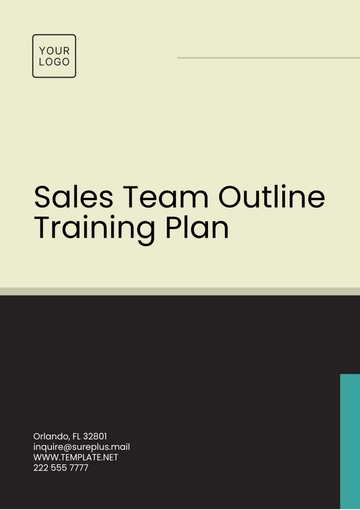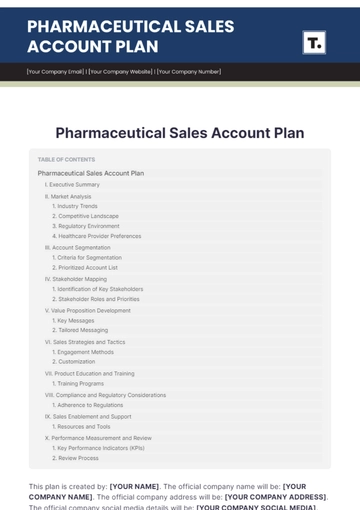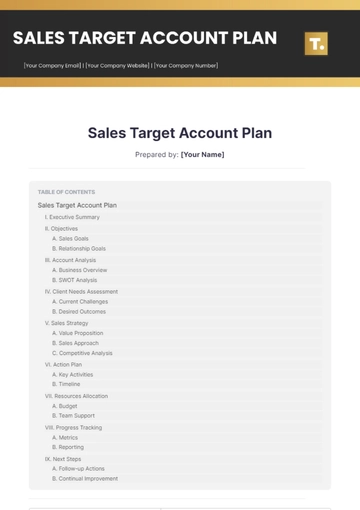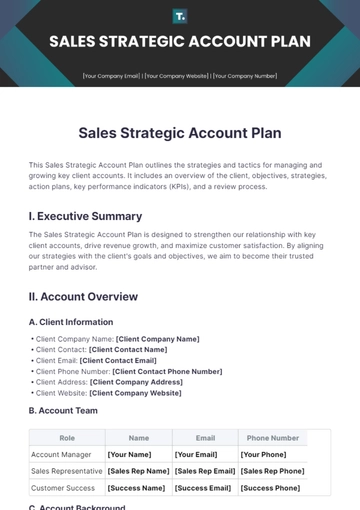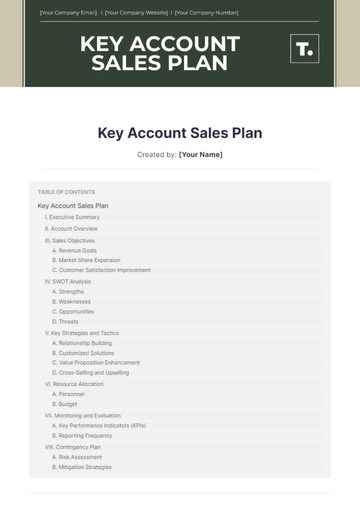Free Sales Strategic Client Partnership and Growth Plan

I. Introduction to Strategic Client Partnership and Growth Plan
This section introduces our Strategic Client Partnership and Growth Plan, focusing on the importance of forming strategic client partnerships in today's business environment. The plan is supported by statistics, case studies, and research findings, demonstrating our commitment to client-focused growth.
A. Purpose and Scope
The primary goal of our plan is to build lasting relationships with our clients and promote sustainable growth. The Sales Strategic Client Partnership and Growth Plan applies to all clients of [Your Company Name], emphasizing our dedication to not just serve, but to partner with our clients for mutual success.
B. Importance of Client Partnerships
The significance of strategic client partnerships is evidenced by their historical impact on business success. Key aspects include:
Enhancing Client Loyalty and Satisfaction: Research shows that strategic partnerships lead to increased client loyalty and satisfaction, building trust and fostering a consistent positive experience.
Unlocking Cross-Selling and Up-Selling Opportunities: Through strategic partnerships, there are opportunities for cross-selling and up-selling, leading to incremental growth beyond basic transactions.
Contributing to Revenue Growth: Data indicates a strong correlation between strategic client partnerships and revenue growth, highlighting the role of these partnerships in driving business success.
The following chapters will delve deeper into the concept of Strategic Client Partnership and Growth, drawing from data, successful case studies, and our commitment to partnering with our clients for shared success.
II. Client Analysis and Segmentation
This section focuses on Client Analysis and Segmentation, a critical aspect in understanding and meeting the unique needs of each client. The aim is to categorize clients effectively and align our strategies with their requirements.
A. Client Profiling
We create detailed profiles for each client, capturing essential information and understanding their background. This includes
Client History and Tenure: Documenting the duration and nature of our relationship with each client.
Current Products/Services Utilized: Identifying the specific products or services each client uses to understand how our offerings meet their needs.
Key Contacts and Their Roles: Recognizing the roles of key individuals in our client organizations to facilitate effective communication and collaboration.
B. Segmentation
Our approach acknowledges the diversity of our client base, segmenting them based on various criteria:
Revenue Contribution: Differentiating clients based on their financial impact on our business.
Industry: Categorizing clients by industry to tailor our approach according to industry-specific challenges and requirements.
Strategic Alignment: Identifying clients whose goals and needs align closely with our offerings and strategic objectives.
C. Needs Assessment
Understanding each client's unique needs, challenges, and objectives is vital:
Client-Specific Needs: Conducting tailored assessments to uncover each client's specific requirements.
Challenges: Identifying and understanding the challenges faced by our clients to find opportunities for growth and collaboration.
Client Feedback and Account Reviews: Using client feedback and regular account reviews as essential tools for gaining insights and guiding our strategic approach.
The following chapters will delve deeper into Client Analysis and Segmentation, emphasizing our commitment to understanding and aligning with our client's unique needs, ultimately aiming for mutual success and sustainable growth.
III. Strategic Growth Initiatives
This section focuses on implementing Strategic Growth Initiatives, emphasizing the importance of action in realizing our growth objectives. These initiatives represent our commitment to proactive growth and outline the specific steps we take to achieve our goals.
A. Account Plans
We use individualized account plans as detailed guides for each key client. These plans include
Growth Objectives and Targets: Clear, measurable targets that guide our growth efforts.
Strategies and Tactics for Achieving Growth: Well-defined plans outlining the steps to achieve growth.
Key Performance Indicators (KPIs) for Tracking Progress: Specific metrics that help us monitor progress and adjust our strategies as needed.
B. Cross-Selling and Up-Selling
We actively pursue cross-selling and up-selling opportunities:
Cross-Selling: Identifying and addressing unmet client needs with additional products or services.
Up-selling: Offering higher-value solutions to enhance client benefits.
C. Relationship Building
Building strong relationships with clients is a key part of our strategy:
Regular Meetings and Check-Ins: Engaging in meaningful interactions to align our efforts with client goals.
Providing Personalized Support and Solutions: Customizing support to meet each client's unique needs.
Proactive Issue Resolution: Addressing challenges promptly and effectively to support client success.
D. Value Proposition
Our value proposition clearly communicates the benefits of our offerings:
It details how our products or services meet specific client needs and deliver tangible benefits.
This proposition is a commitment to our clients' success, reinforcing the value we bring to their business.
In subsequent chapters, we will examine the practical aspects of Strategic Growth Initiatives. Our focus is on converting intentions into actions that drive mutual growth and success. This journey highlights our dedication to proactive growth, acknowledging that our success is closely tied to that of our clients.
IV. Execution and Monitoring
This section covers the critical areas of Execution and Monitoring in strategic growth, focusing on transforming plans into actions and ensuring alignment with our goals.
A. Implementation
Effective execution of plans is essential:
Timelines: We allocate time precisely, understanding its value and finite nature.
Responsible Parties: We assign clear responsibility to individuals or teams for each initiative, ensuring accountability.
Resource Allocation: Resources are allocated efficiently, recognizing the need for judicious use.
Our execution plans are integrated with our account plans and strategic objectives to ensure cohesive action.
B. Key Performance Indicators (KPIs)
KPIs are essential for measuring success:
Revenue Growth: We track revenue growth accurately, recognizing its importance in our overall success.
Client Satisfaction Scores: These scores are used to quantitatively assess how well we meet client expectations.
Product Adoption Rates: We monitor how well our products are adopted by clients, ensuring they meet their needs effectively.
C. Monitoring and Evaluation
Ongoing assessment is key to our strategy:
Feedback from Clients: We actively seek client feedback, valuing it as a critical source of insight.
Feedback from Sales Teams: Insights from our sales teams are crucial as they are directly engaged with clients.
Performance Data: We use data to evaluate the effectiveness of our strategies and make necessary adjustments.
In the following chapters, we will explore how Execution and Monitoring play a vital role in ensuring that our strategic plans are effectively realized and that our progress is measurable. This process underscores our commitment to precision and accountability in achieving our goals.
V. Review and Optimization
This section is dedicated to the processes of Review and Optimization, emphasizing the need for ongoing refinement and improvement in our approach to strategic client partnerships and growth.
A. Periodic Review
Regular reviews are essential for maintaining alignment with our goals:
Assessing the Progress of Growth Initiatives: We evaluate the effectiveness of our growth initiatives systematically, ready to make necessary adjustments.
Identifying Emerging Opportunities and Challenges: We proactively identify both opportunities and challenges to ensure we remain proactive and responsive.
Updating Account Plans as Needed: Account plans are regularly updated to reflect changes and maintain their relevance.
B. Feedback Loop
Feedback is a crucial part of our strategy:
Collecting Client Feedback: We actively gather feedback from our clients to understand their needs and perspectives.
Responsiveness: We use client feedback to make informed, responsive improvements in our strategies and operations.
C. Continuous Improvement
We are committed to continual enhancement of our practices:
Adaptation Based on Lessons Learned: We integrate the lessons from our experiences into our future strategies.
Alignment with Market Dynamics: We continuously adjust our strategies to stay in tune with the evolving market.
Exploration of New Growth Opportunities: We actively seek and explore new growth opportunities, fostering innovation and adaptability.
In the subsequent chapters, we will explore the importance of Review and Optimization in our approach to strategic growth, highlighting our commitment to a dynamic and adaptive path toward success.
- 100% Customizable, free editor
- Access 1 Million+ Templates, photo’s & graphics
- Download or share as a template
- Click and replace photos, graphics, text, backgrounds
- Resize, crop, AI write & more
- Access advanced editor
Elevate your sales strategy with Template.net's Sales Strategic Client Partnership and Growth Plan Template. Craft a roadmap for nurturing key client relationships and fostering sustainable growth using our AI Editor Tool. This editable and customizable template offers strategic insights to help you maximize client value, ensuring long-term success for your business.
You may also like
- Finance Plan
- Construction Plan
- Sales Plan
- Development Plan
- Career Plan
- Budget Plan
- HR Plan
- Education Plan
- Transition Plan
- Work Plan
- Training Plan
- Communication Plan
- Operation Plan
- Health And Safety Plan
- Strategy Plan
- Professional Development Plan
- Advertising Plan
- Risk Management Plan
- Restaurant Plan
- School Plan
- Nursing Home Patient Care Plan
- Nursing Care Plan
- Plan Event
- Startup Plan
- Social Media Plan
- Staffing Plan
- Annual Plan
- Content Plan
- Payment Plan
- Implementation Plan
- Hotel Plan
- Workout Plan
- Accounting Plan
- Campaign Plan
- Essay Plan
- 30 60 90 Day Plan
- Research Plan
- Recruitment Plan
- 90 Day Plan
- Quarterly Plan
- Emergency Plan
- 5 Year Plan
- Gym Plan
- Personal Plan
- IT and Software Plan
- Treatment Plan
- Real Estate Plan
- Law Firm Plan
- Healthcare Plan
- Improvement Plan
- Media Plan
- 5 Year Business Plan
- Learning Plan
- Marketing Campaign Plan
- Travel Agency Plan
- Cleaning Services Plan
- Interior Design Plan
- Performance Plan
- PR Plan
- Birth Plan
- Life Plan
- SEO Plan
- Disaster Recovery Plan
- Continuity Plan
- Launch Plan
- Legal Plan
- Behavior Plan
- Performance Improvement Plan
- Salon Plan
- Security Plan
- Security Management Plan
- Employee Development Plan
- Quality Plan
- Service Improvement Plan
- Growth Plan
- Incident Response Plan
- Basketball Plan
- Emergency Action Plan
- Product Launch Plan
- Spa Plan
- Employee Training Plan
- Data Analysis Plan
- Employee Action Plan
- Territory Plan
- Audit Plan
- Classroom Plan
- Activity Plan
- Parenting Plan
- Care Plan
- Project Execution Plan
- Exercise Plan
- Internship Plan
- Software Development Plan
- Continuous Improvement Plan
- Leave Plan
- 90 Day Sales Plan
- Advertising Agency Plan
- Employee Transition Plan
- Smart Action Plan
- Workplace Safety Plan
- Behavior Change Plan
- Contingency Plan
- Continuity of Operations Plan
- Health Plan
- Quality Control Plan
- Self Plan
- Sports Development Plan
- Change Management Plan
- Ecommerce Plan
- Personal Financial Plan
- Process Improvement Plan
- 30-60-90 Day Sales Plan
- Crisis Management Plan
- Engagement Plan
- Execution Plan
- Pandemic Plan
- Quality Assurance Plan
- Service Continuity Plan
- Agile Project Plan
- Fundraising Plan
- Job Transition Plan
- Asset Maintenance Plan
- Maintenance Plan
- Software Test Plan
- Staff Training and Development Plan
- 3 Year Plan
- Brand Activation Plan
- Release Plan
- Resource Plan
- Risk Mitigation Plan
- Teacher Plan
- 30 60 90 Day Plan for New Manager
- Food Safety Plan
- Food Truck Plan
- Hiring Plan
- Quality Management Plan
- Wellness Plan
- Behavior Intervention Plan
- Bonus Plan
- Investment Plan
- Maternity Leave Plan
- Pandemic Response Plan
- Succession Planning
- Coaching Plan
- Configuration Management Plan
- Remote Work Plan
- Self Care Plan
- Teaching Plan
- 100-Day Plan
- HACCP Plan
- Student Plan
- Sustainability Plan
- 30 60 90 Day Plan for Interview
- Access Plan
- Site Specific Safety Plan



